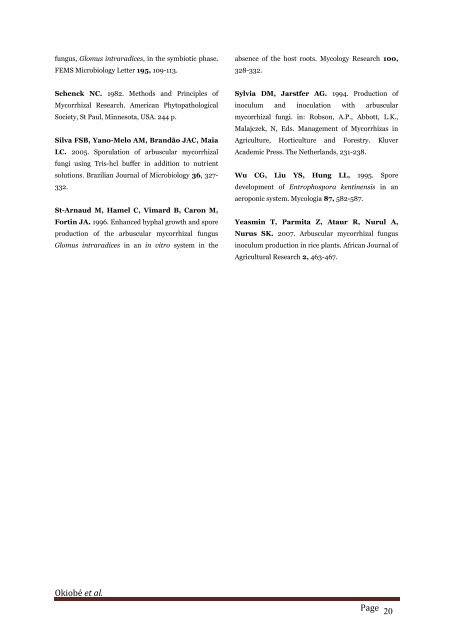Improvement of arbuscular mycorrhizal fungi inoculum production by nutrient solution concentration and soil texture variation
Abstract Arbuscular Mycorrhizal Fungi (AMF) can increase the yield of plants from 50 to 200 %, but the large scale multiplication of AMF inocula is difficult because of their trophic nature, and this represents a big challenge in tropical areas. Within the framework of the study, two separate experiments were conducted in order to determine the most favorable conditions for AMF spore production. The effect of Rorison’s nutrient solution (0, 4 and 8 ml/l) was tested on 6 types of AMF strains for spores production, while in the second experiment; it was the effect of soil-sand mixture variation (5-57 % clay content) that was evaluated in AMF spores production. A local variety of Sorghum bicolor was used as the host plant during the trials. Experiments were performed in completely randomized design with 4 replicates. Results showed that Rorison’s nutrient solution and soil texture significantly (P<0.05) influenced plant growth, symbiotic and biochemical parameters. Nutrient solution induced significant increase in root colonization (5 to 36 %), and AMF spore production (12 to 23 spores/g of soil). The highest concentration of Rorison’s nutrient solution promoted more spore formation, but that was not translated in plant yield. Soil texture variation had a significant impact on AMF root colonization and spores production, since mixture of sand and clay, with clay variation from 20-43% was found to favor both parameters. These data suggest that soil texture variation and nutrient solution concentration can significantly improve AMF spores production and Sorghum symbiotic performances.
Abstract
Arbuscular Mycorrhizal Fungi (AMF) can increase the yield of plants from 50 to 200 %, but the large scale multiplication of AMF inocula is difficult because of their trophic nature, and this represents a big challenge in tropical areas. Within the framework of the study, two separate experiments were conducted in order to determine the most favorable conditions for AMF spore production. The effect of Rorison’s nutrient solution (0, 4 and 8 ml/l) was tested on 6 types of AMF strains for spores production, while in the second experiment; it was the effect of soil-sand mixture variation (5-57 % clay content) that was evaluated in AMF spores production. A local variety of Sorghum bicolor was used as the host plant during the trials. Experiments were performed in completely randomized design with 4 replicates. Results showed that Rorison’s nutrient solution and soil texture significantly (P<0.05) influenced plant growth, symbiotic and biochemical parameters. Nutrient solution induced significant increase in root colonization (5 to 36 %), and AMF spore production (12 to 23 spores/g of soil). The highest concentration of Rorison’s nutrient solution promoted more spore formation, but that was not translated in plant yield. Soil texture variation had a significant impact on AMF root colonization and spores production, since mixture of sand and clay, with clay variation from 20-43% was found to favor both parameters. These data
suggest that soil texture variation and nutrient solution concentration can significantly improve AMF spores production and Sorghum symbiotic performances.
You also want an ePaper? Increase the reach of your titles
YUMPU automatically turns print PDFs into web optimized ePapers that Google loves.
fungus, Glomus intraradices, in the symbiotic phase.<br />
FEMS Microbiology Letter 195, 109-113.<br />
absence <strong>of</strong> the host roots. Mycology Research 100,<br />
328-332.<br />
Schenck NC. 1982. Methods <strong>and</strong> Principles <strong>of</strong><br />
Mycorrhizal Research. American Phytopathological<br />
Society, St Paul, Minnesota, USA. 244 p.<br />
Silva FSB, Yano-Melo AM, Br<strong>and</strong>ão JAC, Maia<br />
LC. 2005. Sporulation <strong>of</strong> <strong>arbuscular</strong> <strong>mycorrhizal</strong><br />
<strong>fungi</strong> using Tris-hcl buffer in addition to <strong>nutrient</strong><br />
<strong>solution</strong>s. Brazilian Journal <strong>of</strong> Microbiology 36, 327-<br />
332.<br />
St-Arnaud M, Hamel C, Vimard B, Caron M,<br />
Fortin JA. 1996. Enhanced hyphal growth <strong>and</strong> spore<br />
<strong>production</strong> <strong>of</strong> the <strong>arbuscular</strong> <strong>mycorrhizal</strong> fungus<br />
Glomus intraradices in an in vitro system in the<br />
Sylvia DM, Jarstfer AG. 1994. Production <strong>of</strong><br />
<strong>inoculum</strong> <strong>and</strong> inoculation with <strong>arbuscular</strong><br />
<strong>mycorrhizal</strong> <strong>fungi</strong>. in: Robson, A.P., Abbott, L.K.,<br />
Malajczek, N, Eds. Management <strong>of</strong> Mycorrhizas in<br />
Agriculture, Horticulture <strong>and</strong> Forestry. Kluver<br />
Academic Press. The Netherl<strong>and</strong>s, 231-238.<br />
Wu CG, Liu YS, Hung LL, 1995. Spore<br />
development <strong>of</strong> Entrophospora kentinensis in an<br />
aeroponic system. Mycologia 87, 582-587.<br />
Yeasmin T, Parmita Z, Ataur R, Nurul A,<br />
Nurus SK. 2007. Arbuscular <strong>mycorrhizal</strong> fungus<br />
<strong>inoculum</strong> <strong>production</strong> in rice plants. African Journal <strong>of</strong><br />
Agricultural Research 2, 463-467.<br />
Okiobé et al.<br />
Page 20





![Review on: impact of seed rates and method of sowing on yield and yield related traits of Teff [Eragrostis teff (Zucc.) Trotter] | IJAAR @yumpu](https://documents.yumpu.com/000/066/025/853/c0a2f1eefa2ed71422e741fbc2b37a5fd6200cb1/6b7767675149533469736965546e4c6a4e57325054773d3d/4f6e6531383245617a537a49397878747846574858513d3d.jpg?AWSAccessKeyId=AKIAICNEWSPSEKTJ5M3Q&Expires=1714813200&Signature=Mb68zQ5AxbVCrRDlqOOiJsp44%2BY%3D)












